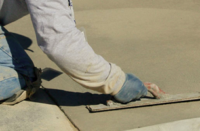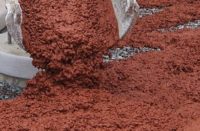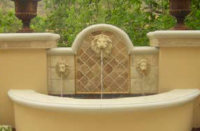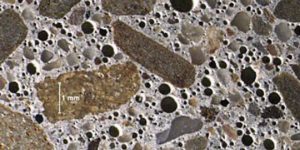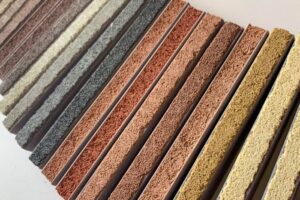
You may never have heard of metakaolin, but chances are it’s coming your way. This admixture — now being used in everything from fashionable floors to custom countertops — makes concrete stronger, brighter and more workable while decreasing the amount of portland cement needed in the mix.
Metakaolin (pronounced meta-ká-lin) is a type of pozzolan, materials that enhance the strength, density and durability of concrete. While decorative concrete contractors are at the vanguard of many concrete innovations, some have been slow to discover these materials. This is changing, however, since high reactivity metakaolin, a relatively new type of pozzolan, offers features unavailable from other highly reactive pozzolans — improved concrete appearance and workability.

Over half of the portland cement concrete used in the United States now contains pozzolans, according to the National Ready Mix Concrete Association. Fly ash and silica fume, the most common pozzolans, are problematic in decorative concrete: They are typically dark in color and, because they are industrial byproducts, are not uniform in color. Silica fume is a highly reactive pozzolan capable of producing very strong and durable concrete, but results in “sticky” mixtures that are difficult to place and finish and require special curing techniques.
High-reactivity metakaolin (HRM), on the other hand, is a white powder that brightens concrete. It is manufactured especially for use in concrete and to assure consistent appearance. It is highly reactive and meets or exceeds the performance of silica fume. But unlike silica fume, it creates a creamy cement paste that is easier to pump, trowels “like butter,” and can be cured with ordinary curing techniques.
Metakaolin is produced from kaolinite, a mineral found in kaolin clay (also known as china clay). The material is purified to remove compounds that could discolor concrete, and then calcined under controlled heat to create an amorphous aluminosilicate that is reactive in concrete. Generally used to replace 5 percent to 20 percent of the portland cement in a mixture, metakaolin also reduces emission of greenhouse gases associated with portland cement manufacturing. A growing number of concrete producers have metakaolin on hand, and it is carried by distributors selling plastering materials to swimming pool contractors.
|
How Pozzolans Affect Concrete Color |
||||
|
Fly Ash
|
||||
|
Silica Fume
|
||||
|
High-Reactivity
Metakaolin |
||||
|
None
|
||||
| Cement: |
white
|
White + Pigment
|
Gray
|
Gray +
Pigment |
|
Metakaolin can be used in white portland cement concrete without compromising its brilliance. Mixed into ordinary gray portland cement, it gives the concrete a lighter value that can create new aesthetic opportunities. It can also be used in integrally colored concrete to lighten and intensify color, and its whiteness and uniformity make it easier to match colors. |
||||
Concrete appearance
In addition to brighter and more consistent color, metakaolin improves concrete appearance in several important ways:
- The improved workability of metakaolin-enriched concrete enables contractors to achieve smoother, denser finishes without over troweling. This results in less trowel burn, reduced mottling, and fewer surface blemishes.
- Metakaolin makes concrete denser so it is less likely to absorb stains that could disfigure a surface.
- As a highly reactive pozzolan, metakaolin consumes lime that might otherwise cause efflorescence. And it resists moisture penetration that can dissolve and transport lime and other soluble minerals to the surface of concrete.
- Alkali silica reaction (ASR) is a chemical reaction between the alkaline lime in concrete and the silica in some types of aggregate. If not mitigated, ASR can crack concrete. Metakaolin is one of the most effective admixtures for preventing ASR and allows crushed recycled glass to be used in decorative concrete.
- Improved durability: Nothing ruins the appearance of decorative concrete more than cracking, corrosion, spalling, or other forms of concrete deterioration. By boosting concrete strength and density, metakaolin provides a safety factor to help keep your work looking its best.

Metakaolin-enhanced concrete
One concrete contractor who has embraced metakaolin is Alan Bouknight, president of Azzarone Contracting Corp. in Mineola, N.Y. He says, “I made samples with metakaolin and put them out in the yard to watch how they fared. After more than three years of exposure to the elements, they show none of the pitting and deterioration we get with typical concrete in our harsh urban environment.”
Since then, Bouknight has used metakaolin in exposed concrete floors for a fashionable Armani Casa showroom, to create a sculptural concrete stairway for the Museum of Modern Art, and for pool decks for a custom beachfront residence.
“Metakaolin gives the concrete more ‘butter’ and enables me to coax out the inherent beauty of concrete in subtle ways,” he says. “It makes concrete more consistent so we can create an ultra smooth surface without flow lines or objectionable blemishes.” Used with white portland cement, metakaolin “can produce beautiful opalescent finishes. Plus, the bright white metakaolin helps intensify the color we are after.”
Tom Ralston, president of Tom Ralston Concrete in Santa Cruz, Calif., is experimenting with metakaolin for concrete countertops, using dosages of up to 10 percent or 15 percent of the cement weight. “Metakaolin will prove to be a very important additive as we continue to improve our countertops,” he says. “It fills in voids and supports the sand particles to ease finishing. Instead of taking three or four swipes with a trowel, you might need only one or two to get a smooth hard finish.”

Metakaolin is an affordable alternative to using white portland cement to lighten the color of concrete, Ralston says. “The colors you can produce with metakaolin are in a range you don’t ordinarily see; we use it if customers want concrete that is just a little more pastel.” He suggests that the higher early strength due to metakaolin could reduce the waiting period before concrete is hard enough to polish, and that the denser concrete may make countertops more stain resistant.
Metakaolin is also finding its way into the fine arts. For example, Andrew Goss, the author of Concrete Handbook for Artists, uses metakaolin in concrete sculpture and jewelry. He says, “Metakaolin can double the compressive strength of the concrete, lowers permeability and increases density but also has advantages over silica fume. Metakaolin makes the mix creamier, less sticky, and is plain white in color.”
Guidelines for use
Concrete with metakaolin can be placed, finished and cured in pretty much the same manner as concrete without HRM. It complies with ASTM C 618 — Specification for Coal Fly Ash and Raw or Calcined Natural Pozzolan for Use as a Mineral Admixture in Concrete, Class N and is accepted under ACI 318 — Building Code Requirements for Structural Concrete and Commentary.

According to Anthony Reed, market development manager for Engelhard Corp.’s MetaMax high-reactivity metakaolin, “At an HRM replacement level of 8 percent to 10 percent, concrete is generally more cohesive and less likely to bleed. As a result, the effort required for pumping and finishing processes is reduced. Compressive strength and density of hardened concrete are also increased. Optimum pozzolanic benefits of metakaolin can be obtained by replacing 10 percent to 20 percent of the portland cement in the mixture with HRM. These levels produce concrete with lower porosity and improved durability and resistance to impact and abrasion.”

Reed also points out that metakaolin reduces concrete slump and generally requires the addition of a high-range water reducer (HRWR). “Metakaolin should generally be added to batch after portland cement and before HRWR is added,” he says. “Air entraining admixtures may require somewhat increased dosage when used with metakaolin.”
When using integrally colored concrete, metakaolin brightens the shade of colored concrete by creating a lighter cementitious base color, according to Nick Paris, marketing manager for Davis Colors.
While metakaolin should have no impact on surface-applied coatings, special consideration must be given when using penetrating stains, Paris explains. “Because metakaolin increases the density of concrete, it may reduce the ability of stain to penetrate the surface. In addition, pozzolans consume some of the lime in concrete and can reduce the ability of chemically active stains to react with lime and develop their color.”
 David Kucera, president of David Kucera Inc., Gardiner, N.Y., a fabricator of precast concrete ornamentation and architectural cladding, points out a further tip on finishing concrete with metakaolin. “Metakaolin makes my concrete more resistant to acid rain, but it also makes it more difficult to use an acid wash to expose the aggregate. I now have to work twice as hard to remove the cement paste.” He admits that this is an ironic testimony to the effectiveness of metakaolin in improving the density of concrete. On the other hand, he says, metakaolin simplifies sandblasting. “The harder concrete makes it easier to keep an edge on a piece, and corners don’t get rounded off as easily.”
David Kucera, president of David Kucera Inc., Gardiner, N.Y., a fabricator of precast concrete ornamentation and architectural cladding, points out a further tip on finishing concrete with metakaolin. “Metakaolin makes my concrete more resistant to acid rain, but it also makes it more difficult to use an acid wash to expose the aggregate. I now have to work twice as hard to remove the cement paste.” He admits that this is an ironic testimony to the effectiveness of metakaolin in improving the density of concrete. On the other hand, he says, metakaolin simplifies sandblasting. “The harder concrete makes it easier to keep an edge on a piece, and corners don’t get rounded off as easily.”
Contractors who have used metakaolin advise that before doing a project with the additive, decorative concrete craftsmen should prepare trial batches using proposed materials in order to refine their mix and technique. “Once they get used to working with it,” Bouknight says, “the guys on my crew love metakaolin, especially how it finishes. It makes them prouder of the work they do.”
